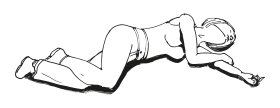The recovery position
| Recovery position | |
|---|---|
| Intervention | |

All forms of the recovery position share basic principles. The mouth is downward so that fluid can drain from the patient's airway; the chin is well up to keep the epiglottis opened. Arms and legs are locked to stabilize the position of the patient
|
The recovery position refers to one of a series of variations on a lateral recumbent or three-quarters prone position of the body, in to which an unconscious but breathing casualty can be placed as part of first aid treatment.
An unconscious person, a person who is assessed on the Glasgow Coma Scale (GCS) at eight or below, in a supine position (on the back) may not be able to maintain an open airway as a conscious person would. This can lead to an obstruction of the airway, restricting the flow of air and preventing gaseous exchange, which then causes hypoxia, which is life-threatening. Thousands of fatalities occur every year in casualties where the cause of unconsciousness was not fatal, but where airway obstruction caused the patient to suffocate. The cause of unconsciousness can be any reason from trauma to intoxication from alcohol.
It is not necessarily used by health care professionals, as they may have access to more advanced airway management techniques, such as intubation.
The recovery position is designed to prevent suffocation through obstruction of the airway, which can occur in unconscious supine patients. The supine patient is at risk of airway obstruction from two routes:
Placing a patient in the recovery position gives gravity assistance to the clearance of physical obstruction of the airway by the tongue, and also gives a clear route by which fluid can drain from the airway.
The International Liaison Committee on Resuscitation does not recommend one specific recovery position, but advises on six key principles to be followed:
The earliest recognition that placing unconscious patients on their side would prevent obstruction of the airway was by Robert Bowles, a doctor at the Victoria Hospital in Folkestone, England. In 1891 he presented a paper with the title 'On Stertor, Apoplexy, and the Management of the Apoplectic State' in relation to stroke patients with noisy breathing from airway obstruction (also known as stertor).
...
Wikipedia
